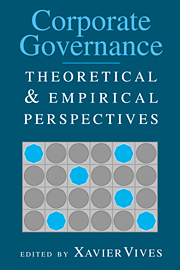Book contents
- Frontmatter
- Contents
- Preface
- Contributors
- 1 Corporate Governance: Does It Matter?
- 2 Corporate Governance and Competition
- 3 On the Economics and Politics of Corporate Finance and Corporate Control
- 4 How Do Financial Systems Affect Economic Performance?
- 5 Information and Governance in the Silicon Valley Model
- 6 The Governance of the New Enterprise
- Index
6 - The Governance of the New Enterprise
Published online by Cambridge University Press: 05 June 2012
- Frontmatter
- Contents
- Preface
- Contributors
- 1 Corporate Governance: Does It Matter?
- 2 Corporate Governance and Competition
- 3 On the Economics and Politics of Corporate Finance and Corporate Control
- 4 How Do Financial Systems Affect Economic Performance?
- 5 Information and Governance in the Silicon Valley Model
- 6 The Governance of the New Enterprise
- Index
Summary
The publication of “The Modern Corporation and Private Property” in 1932 by Adolph Berle and Gardiner Means set the terms of the modern debate on corporate governance. Berle and Means focused on the separation of ownership and control in large corporations where multiple layers of salaried managers coordinated production and distribution. What is perhaps less well recognized about their work is that the large public corporation had only recently become the dominant way of organizing production in the United States (see Chandler 1977). The book was therefore prescient in that it recognized this way of organizing the enterprise would be lasting, and hence it was important to study how they would be governed.
At that time, the archetypical public firm was General Motors. The enduring fascination with this firm has been, in part, because of its size and the industry it is in, and, in part, because it was the focus of two of the best known managerial books, Alfred Sloan's My Years with General Motors and Peter Drucker's The Concept of the Corporation.
GM was, and in large part still is, a vertically integrated firm, which owned and controlled a large amount of highly specialized inanimate assets, ranging from plant and machinery to world-famous brand names. In the past, as we will argue, these assets were very hard to replicate and were primarily what made the firm unique. The human capital of employees was, in large part, tied to these assets and immobile.
- Type
- Chapter
- Information
- Corporate GovernanceTheoretical and Empirical Perspectives, pp. 201 - 232Publisher: Cambridge University PressPrint publication year: 2000
- 119
- Cited by



